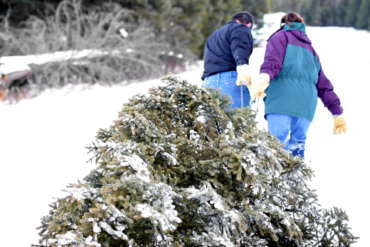Climbing requires very specific gear, much of it protecting life and limb. So it makes sense when climbers are super picky about the gear they choose for their vertical adventures.
Gift-giving to the climbers in your orbit can be a difficult task. Let the core climbers at GearJunkie help you choose a gift that can keep your climbing friends and family safe, comfortable, and performing well in their endeavors to evade gravity.
Edelrid Swift Protect Pro Dry 8.9 Rope

Nothing is more symbolic of climbing safety than the rope. And in a majority of cases, climbers use a single line. Cutting this single cord on a sharp rock edge is the stuff of nightmares.
Until the Edelrid Swift Protect Pro Dry 8.9 ($330) came out, it was impossible to say that a single dynamic climbing rope was “cut-resistant.” But the engineers at Edelrid figured out how to incorporate aramid in the sheath and still maintain the elasticity required for dynamic ropes. Aramid is very cut-resistant but inelastic.
The result? You can read all about it in our review. The short story is, when our climbing editor Seiji Ishii needs a single dynamic rope, this is the first rope he chooses. For him, peace of mind is worth the price of admission — and the rope has proven over multiple seasons to stand up to Edelrid’s claims.
Check Price at REICheck Price at Amazon
Petzl GriGri+ Belay Device

Beginner climbers may learn to belay on a tube-style belay device. But very soon, they will most likely be exposed to, and want to use, an assisted-braking belay device. And no other device can get close to the popularity of the Petzl GriGri.
The latest version, dubbed the GriGri+ ($140), has one standout feature: an “anti-panic” lowering handle that will lock the rope if the climber starts to descend too quickly.
The GriGri+ also has toprope and lead climbing modes. The lead climbing mode allows slack to be delivered faster to the climber, which is crucial during desperate clips. You can find out more on our First Look review.
Our climbing editor has tested (and still tests) every assisted-braking belay device. On his personal days out, he grabs the Petzl GriGri+.
Check Price at REICheck Price at Backcountry
Metolius Super Chalk

A rock climber can never have enough chalk. Even if they stockpile it, they will eventually use it. And climbing chalk never goes bad. The short of it: If you gift a rock climber chalk, it will get used. It’s a staple for rock jocks.
Metolius Super Chalk ($5-14) is just that: 100% magnesium carbonate, with no drying agents or other added chemicals. Climbers inhale chalk, eat chalk, get chalk all over their cars, homes, pets, clothes, you name it. It’s nice to know that Super Chalk is pure chalk and nothing else.
Our climbing editor Seiji Ishii has sampled more chalk than imaginable. And he feels the chunk-to-powder ratio is perfect and that the price is affordable amid the introduction of “premium” chalk brands.
Check Price at REICheck Price at Backcountry
Osprey Zealot Chalk Bucket

For bouldering, a chalk bucket is the way to go. Falling with a chalk bag around the waist makes a mess, wholly unappreciated at the gym and outdoor boulders. And then there’s that extra weight (that we claim makes a difference).
There are plenty of chalk buckets, mostly from bouldering or core climbing brands. But this one from Osprey Packs solves a universal problem for boulderers. We’ve all done it — you chalk up and drop your bucket on the ground, only to launch chalk everywhere. You forgot to close it, or the Velcro is so gummed up it fails to keep the bucket closed. Or you accidentally kick it over because you are eyeing the hold that spits you off.
The Osprey Zealot Chalk Bucket ($25) addresses all this with powerful magnets in the roll-top closure that seal it up almost automatically. The bag also has loops to carry brushes horizontally or vertically. The fabrics are Bluesign-approved recycled nylons.
Check Price at AmazonCheck Price at Osprey
Rhino Skin Solutions Repair Cream

It doesn’t matter what kind of climbing you do — the skin on your hands gets annihilated. There are plenty of lotions, creams, oils, bars, and other concoctions claiming to magically heal paws, but nothing has worked for our climbing editor better than Rhino Skin Solutions Repair Cream.
Rhino Skin Repair Cream ($19) does what other lotions do: hydrates and nourishes the skin. But what the others don’t do is encourage regeneration by helping remove the outer, beat-up layer of skin with salicylic acid derived from cattails. This signals the deeper layers to step up production.
Analgesic menthol soothes the burning tips so you can drive home with something other than your wrists. The cream is balanced out with essential oils, tea tree, rosemary, and thyme.
Check Price at AmazonDMM Ceros Locking Carabiner

Carabiners are rated along the long axis and are meant to be loaded that way. But a locking belay carabiner can spin on the belay loop, and the belay device, especially a larger assisted-braking version, can move away from the intended position. This can cross-load the carabiner, which isn’t ideal. And in worst-case scenarios, it could be dangerous.
There are many locking carabiners specifically engineered for use as a belay carabiner. They have captive belay loop locks, and many incorporate a gate that secures automatically. But none of the ones our climbing editor has tested specifically addresses an assisted-braking device migrating from the correct position at the top of the carabiner.
Until the DMM Ceros ($23). This pear-shaped locking belay carabiner has the requisite spring-loaded captive lock for the belay loop. But it also has a horn on the belay device side that keeps the assisted-braking device in place. The device can’t migrate past this horn or past the top of the gate. It’s always where expected and it cannot cross-load the carabiner.
DMM offers both screw gates and autolocking gates on the Ceros.
Check Price at AmazonCheck Price at Backcountry
Metolius Session II Crash Pad

Bouldering requires less gear than any other form of climbing. A crash pad is one of the few musts.
The Metolius Session II ($200) is the bestselling pad in America, and for good reason. It has just the right amount of features to make it convenient to use, and the 4 inches of multiple densities of foam have done well over many seasons under our editor’s training boards and countless boulders.
The 3 x 4-foot landing zone uses a hingeless design, so there is no gutter to potentially twist an ankle. And the 900-denier polyester outer fabric guards against the harsh reality of bouldering environments. A “cross-clipper” carpet gets your shoe rubber clean and the legendary aluminum speed-hook buckles are guaranteed for life. All for a price that remains reasonable.
Some of the Metolius pads in our climbing editor’s collection have been dragged, landed on, and slept aboard for over a decade, and they are still in rotation. He expects the Session II to follow suit. Read our full review of the Metolius Session II.
Check Price at REICheck Price at Amazon
Black Diamond Equipment Camalot Z4

Trad and alpine climbers can never have too many cams. And if you’re going to put your hard-earned money into cams, it’s hard to argue against the Black Diamond Camalot.
And the Camalot Z4 ($85) is no exception. The single stem on this patented cam has the unique and useful ability to remain stiff when the trigger is pulled, yet flexible once placed. You get easier plugging while reducing chances that the cam “walks” out of the placement. This incredible duality is made possible by what Black Diamond logically calls the RigidFlex stem. Our climbing editor Seiji Ishii attests that this clever tech delivers as promised.
The four lobes are sandblasted for better bite and the stem on the larger cams uses dual twisted cables to provide uniform flexibility in all directions. The Black Diamond Equipment Camalot Z4 size range is zero (the smallest cam BD has ever made) to 0.75. Read our review of the Camalot Z4 for more features.
Check Price at REICheck Price at Amazon
Trango Beta Stick EVO

Sometimes you just have to stick-clip that first bolt. Back in the day, this involved finding the correct stick, a suitable pebble or twig, and busting out the finger tape. But we have evolved, and commercially-available stick clips make this once-arduous task simple and quick.
Our climbing editor, who shunned such activity in his youth, now stick-clips with aplomb. And he’s tested every version, from the paint pole with a hardware store clamp to crazy contraptions with pulleys, springs, and strings. For getting the draw and rope up, his favorite is the Trango Beta Stick EVO.
The Trango Beta Stick EVO ($88) comes in three lengths, extending from 8 to 22 feet. The pole sections are triangular in cross-section, so they resist spinning on one another, and the snap locks engage and disengage easily with a lever (no more wrenching a collar with sore skin). The head uses an adjustable wire arm that holds both solid and wire gates open and has a hole so you can clip it to your harness to go full-on sport mode, bolt to bolt.
The Beta Stick EVO can also pull a rope down and remove a quickdraw from a bolt. Our climbing editor has also clipped the rope into the draw with a little finagling.
Check Price at REICheck Price at Amazon
Petzl Spirit Screw Lock

Regardless of what kind of climbing, it seems like you never have enough utility locking carabiners. From building anchors, setting top ropes, or rigging crucial quickdraws, having multiple lockers keeps things safe.
Our climbing editor has more carabiners than he can count and has taken all sorts of lockers up cliffs, ice, and mountains. And the Petzl Spirit Screw Lock ($17) is the only one he uses on personal days for a utility locker.
Petzl bases the Spirit Screw Lock on their proven Spirit carabiner. The H cross section keeps it light, the Keylock system resists snagging, and the relatively compact size means it’s never a burden to bring a few more, just in case.
Check Price at REICheck Price at Amazon









